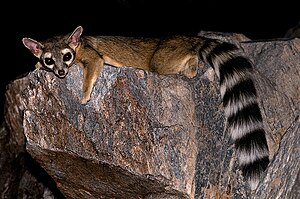Katzenfrette
| Katzenfrette | ||||||||||||
|---|---|---|---|---|---|---|---|---|---|---|---|---|

North American cat fret ( Bassariscus astutus ) |
||||||||||||
| Systematics | ||||||||||||
|
||||||||||||
| Scientific name | ||||||||||||
| Bassariscus | ||||||||||||
| Coues , 1887 |
Katzenfrette ( Bassariscus ) are a genus of small bears (Procyonidae) that is regarded as particularly original . The genus has been proven to be fossilized since the Miocene . Today there are two types of these animals, which are more reminiscent of crawling cats :
- North American cat fret ( Bassariscus astutus )
- Central American cat frett ( Bassariscus sumichrasti )
features
Katzenfrette have large ears and eyes and a pointed snout; the face has a whitish-black markings. Otherwise the fur is beige on the top and whitish on the underside. The black and white banded tail, which gave the Katzenfrett the name "Ringtail" or "Ring-tailed Cat", is striking. The two types are difficult to distinguish from one another; the coat of the Central American cat frett is a tad darker. Above all, only the North American cat fret can retract its claws; the Central American cat frett cannot do this. The North American cat frett reaches a head body length of 30 to 37 centimeters, a tail length of 31 to 44 centimeters and a weight of 0.87 to 1.1 kilograms. The Central American species is slightly larger with head body lengths of 38 to 50 centimeters and tail lengths of 39 to 55 centimeters.
habitat
The North American cat frett inhabits the southwestern United States and northern Mexico . The Central American cat frett is widespread from southern Mexico to Panama . While the first species prefers steppes and bushland as habitat , the Central American species is an inhabitant of tropical rainforests .
Way of life
Katzenfrette are omnivores. They hunt for small mammals , birds and insects and rob bird nests; they also eat berries and fruit.
The large eyes identify the cat frett as a nocturnal animal. It rests in caves that are about 4 m high and are either in trees, rocks or columnar cacti . When sleeping, it wraps its tail around the body to keep it warm.
Reproduction
There are two to four young in a litter, who are born after a gestation period of around 51 to 65 days. You are initially blind and helpless. At eight weeks of age, they acquire the ability to leave the nest and accompany the mother. After four months they are self-employed.
In human care, Katzenfrette can live to be over twenty years old. They are likely to fall victim to an enemy much earlier in the wild, e.g. B. a lynx or an eagle owl .
Katzenfrette and humans
Katzenfrette were used to control rodents , their fur is commercially used to a small extent. Their meat is also eaten in Central America.
The North American cat fret was able to expand its range in the 20th century and is now widespread as far as Kansas and Alabama . It is well researched and well known in its habitat, it is one of the widespread and not endangered species.
The Central American cat fret, on the other hand, is rarer and its population is increasingly threatened by deforestation; the IUCN lists it as Least Concern.
designation
The German name comes from the fact that the animals , which outwardly resemble cats , were used to hunt rodents, similar to ferrets . Sometimes there is also the term "Cacomistle" or "Kakamizli", which comes from the Indian Nahuatl language and means something like "half puma". In English they are either referred to as "cacomistle" or, because of their curly tail, as "ringtails". Since they were used to control rodents in mines in the USA well into the 20th century , they have also been given the name "Miner's cats". Another name, "Civet cat", is due to the fact that the animals can exude a musky odor from the anal glands . The name can, however, lead to confusion with the civets belonging to the crawling cats .
Individual evidence
- ↑ a b c d Roland Kays: Genus Bassariscus, pages 525-526 in Don E. Wilson , Russell A. Mittermeier : Handbook of the Mammals of the World - Volume 1 Carnivores. Lynx Editions, 2009, ISBN 978-84-96553-49-1 .
- ↑ Bassariscus sumichrasti in the endangered Red List species the IUCN 2016 Posted by: Pino, J., Samudio Jr, R., González-Maya, JF & Schipper, J., 2015. Accessed April 16, 2016th